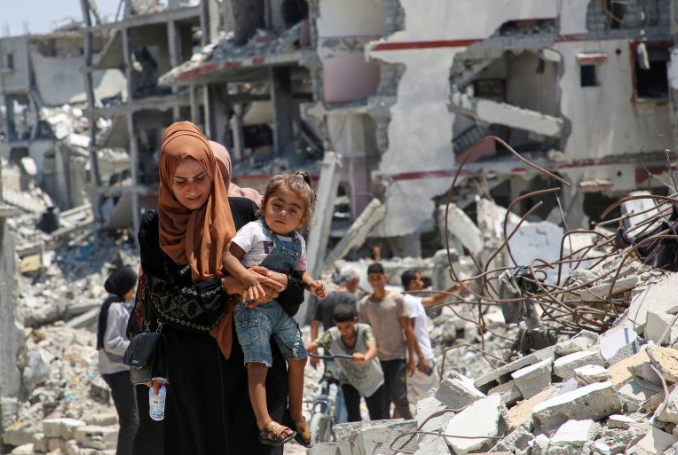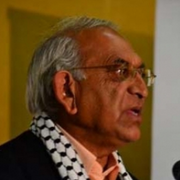
By Iqbal Jassat
The question posed by Abu Sitta is how individuals and nations will respond, knowing what is happening and understanding the consequences of inaction.
Palestine’s foremost historian, Salman Abu Sitta, renowned for his cartographic work as well as his compelling studies on Palestinian Right of Return, has sketched a brief overview of Gaza’s past and his prognosis of the genocidaires’ ultimate goal.
Born in 1937 in Palestine and an engineer by profession, Prof Abu Sitta has authored numerous books, including The Atlas of Palestine, 1917-1966 (2010). As a scholar and academic, his energetic activism in pursuit of Palestinian rights has earned him enormous respect.
His memoir, Mapping My Return, offers a personal account of Al Nakba in southern Palestine. A former member of the Palestine National Council, Abu-Sitta has participated in numerous international forums on Palestinian rights and delivered a notable address, A Palestinian Address to Balfour, at the University of Edinburgh in 2022.
As recently as January 2025, Abu-Sitta spoke to Jurist’s Senior Editor for Long Form Content, Pitasanna Shanmugathas, about his childhood in Palestine before the establishment of the state of Israel in 1948 on his land, how he and his family survived the Nakba, his family’s current situation in Gaza, and his detailed proposal for implementing the Palestinian Right of Return.
Dr. Salman Abu-Sitta:
“I was born in 1937 in al-Ma’in Abu-Sitta, a 6,000-hectare area in the Beersheba district that my family had owned for over 200 years. Al-Ma’in, named after my family, was part of a vibrant agricultural community.
“We cultivated wheat, barley, grapes, figs, and almonds, and raised sheep, camels, and cattle. My father built a school in 1920, a flour mill, with four silos for our wheat and barley, reflecting our self-sufficient and prosperous ways of life. Education was highly valued in my family — my father built the first school in 1920 at his expense, by the 1930s, my brothers were pursuing high school in Jerusalem and by 1944, four of them were in university in Cairo.
“Palestine at that time was a land of established communities, rich culture, and resilience. However, British policies under the Mandate, such as facilitating Jewish immigration and land acquisition, began to destabilize the country. My father and relatives resisted, fighting the British in World War I, including at the Suez Canal, and later during the Arab Revolt of 1936-1939. My brother led the Revolt in the Beersheba district, where we expelled British forces for a year and even established a local government.
“This resilience was met with brutal suppression by the British, who bombed Palestinian villages and supported the growing Zionist movement. By 1948, the situation reached a devastating climax. On May 14, 1948, the Zionist militia Haganah attacked our land with 24 armored vehicles, burning our homes, destroying the school my father built, and expelling us from al-Ma’in. That day, coinciding with the declaration of the state of Israel, marked the beginning of my life as a refugee — a status I have endured for over 28,000 days.”
On his current understanding of Israel’s plan for the Gaza Strip, Abu Sitta takes us through a few stages from Creation to Elimination.
He points out that Israel “created” the Strip in 1948 by attacking and depopulating 212 cities and villages in the southern district of Palestine (12,500 km2).
“Israel forced the population into a concentration camp named Gaza Strip (area 550 km2) bounded by the Armistice Agreement of February 1949 (thick black line).”
On the question of shrinking, he recalls that in February 1950, Israel complained of clashes with the returning refugees and proposed a temporary armistice line (Modus Vivendi), thus chopping off 200 km2 from the Gaza Strip to the present area of 365 km2. (thin black line).
“Contrary to its undertaking and international agreement, Israel never returned to the original armistice line.”
Turning to genocide, Abu Sitta asserts that since 1953, Israel has committed many massacres in the Gaza Strip and demolished camps.
“In 2023- 2025, Israel committed the biggest genocide in recent history, in which 377,000 people, mostly women and children, were killed. Gaza Strip was reduced to be a graveyard.”
The final aspect he deals with is headed elimination. He warns that Israel now plans to obliterate the Gaza Strip altogether.
First, by creating a new boundary (red line), chopping off 54% of the original area and removing the surviving population out of the area altogether.
“The hidden secret is the huge newly occupied Rafah area will be used to create a huge deep crater extending several kilometers and demolish all the tunnels of the resistance forces.”
Abu Sitta’s dire warning may sound alarmist, but the reality is that Netanyahu’s goal to annihilate all Palestinians in Gaza has been viciously underway via horrific military attacks.
As a refugee from Gaza, where most of his family are, Abu Sitta said their suffering is indescribable. “The ongoing assault on Gaza has turned life into an unimaginable horror.”
None can deny that a genocide is happening in real-time, visible to the world through the screens of cellphones and televisions. It’s not a distant historical event — it’s unfolding now.
The question posed by Abu Sitta is how individuals and nations will respond, knowing what is happening and understanding the consequences of inaction.

– Iqbal Jassat is an Executive Member of the South Africa-based Media Review Network. He contributed this article to The Palestine Chronicle. Visit: www.mediareviewnet.com
(Except for the headline, this story has not been edited by PostX News and is published from a syndicated feed.)
